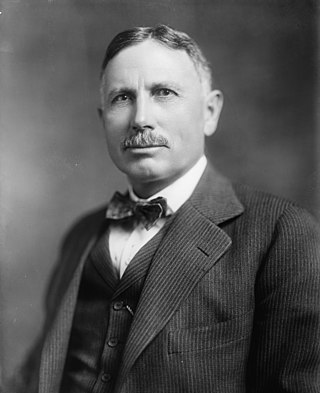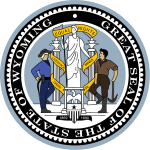
The 1968 United States Senate elections were elections for the United States Senate. Held on November 5, the 34 seats of Class 3 were contested in regular elections. They coincided with the presidential election of the same year. The Republicans picked up five net seats in the Senate. This saw Republicans win a Senate seat in Florida for the first time since Reconstruction.

The 1960 United States Senate elections coincided with the election of John F. Kennedy as president on November 8, 1960. The 33 seats of Class 2 were contested in regular elections. A special election was also held on June 28, 1960, for a mid-term vacancy in North Dakota where Democrats flipped a seat to expand their majority to 66–34. As Majority Leader Lyndon Johnson was elected Vice President, Mike Mansfield became the new majority leader.

Joseph Christopher O'Mahoney was an American journalist, lawyer, and politician. A Democrat, he served four complete terms as a U.S. senator from Wyoming on two occasions, first from 1934 to 1953 and then again from 1954 to 1961.

John Benjamin Kendrick was an American politician and cattleman who served as a United States senator from Wyoming and as the ninth Governor of Wyoming as a member of the Democratic Party.

The 1912–13 United States Senate elections were held on various dates in various states. They were the last U.S. Senate elections before the ratification of the Seventeenth Amendment in 1913, establishing direct elections for all Senate seats. Senators had been primarily chosen by state legislatures. Senators were elected over a wide range of time throughout 1912 and 1913, and a seat may have been filled months late or remained vacant due to legislative deadlock. Some states elected their senators directly even before passage of Seventeenth Amendment. Oregon pioneered direct election and experimented with different measures over several years until it succeeded in 1907. Soon after, Nebraska followed suit and laid the foundation for other states to adopt measures reflecting the people's will. By 1912, as many as 29 states elected senators either as nominees of their party's primary or in conjunction with a general election.
The Wyoming Democratic Party is the affiliate of the Democratic Party in Wyoming, headquartered in Cheyenne. The party was strong during Wyoming's territorial days, but suffered a decline in its early statehood. It rose to prominence again from the 1930s to the 1950s before experiencing another decline.

The 2008 United States Senate special election in Wyoming took place on November 4, 2008, at the same time as the regular election to the United States Senate in Wyoming. The special election occurred to complete the term of Republican incumbent Craig L. Thomas, who won reelection in 2006, but died in June 2007. Despite being a Democrat, Governor Dave Freudenthal was obliged by state law to appoint a Republican, and selected state senator John Barrasso, who was unopposed in the Republican primary and won the general election to fill the remainder of the term ending January 3, 2013. This is the last time that both of Wyoming‘s U.S. Senate seats were concurrently up for election.

The 1996 United States Senate election in Wyoming was held November 5, 1996. Incumbent Republican U.S. Senator Alan K. Simpson decided to retire. Republican nominee Mike Enzi won the open seat.

The 1890–91 United States Senate elections were held on various dates in various states. As these U.S. Senate elections were prior to the ratification of the Seventeenth Amendment in 1913, senators were chosen by state legislatures. Senators were elected over a wide range of time throughout 1890 and 1891, and a seat may have been filled months late or remained vacant due to legislative deadlock. In these elections, terms were up for the senators in Class 3.

The 1960 United States Senate election in Wyoming was held on November 8, 1960. Incumbent Democratic Senator Joseph C. O'Mahoney was first appointed to the U.S. Senate from Wyoming's Class 1 Senate seat in 1934, and was re-elected in 1934, 1940, and 1946 before losing re-election in 1952. He was then elected to the Class 2 Senate seat in 1954. O'Mahoney, in failing health and increasingly limited in his mobility, declined to run for a fifth non-consecutive term in the Senate. The winner of this election, Keith Thomson, died before assuming his elected office.

A general election was held in the U.S. state of Wyoming on November 6, 2018. All of Wyoming's executive offices were up for election, as well as a United States Senate seat and Wyoming's at-large seat in the United States House of Representatives. Primary elections were held on August 21, 2018.

The 1922 United States Senate election in Washington was held on November 7, 1922. Incumbent Republican Miles Poindexter ran for a third term in office, but was defeated by Democrat Clarence C. Dill in a three-way race that also featured Farmer-Labor nominee James Duncan.

The 1922 United States Senate election in Wyoming took place on November 7, 1922. First-term Democratic Senator John B. Kendrick ran for re-election to a second term. He was opposed by Republican Congressman Frank W. Mondell, the Majority Leader of the U.S. House of Representatives. Kendrick won re-election by a wide margin, defeating Mondell, despite his long record of representing the state in Congress, with 57% of the vote to Mondell's 43%. Kendrick was also able to increase his margin of victory from 1916, despite Republicans generally doing well in Wyoming in 1922.

The 1928 United States Senate election in Wyoming took place on November 6, 1928. Democratic Senator John B. Kendrick ran for re-election to a third term. He faced Republican Congressman Charles E. Winter in the general election, and a competitive general election ensued. Kendrick ended up winning re-election by a narrow margin, with Winters's campaign likely assisted by the strong performance of Herbert Hoover in that year's presidential election. Kendrick's third term would turn out to be his last; he died while in office on November 3, 1933, about a year until the seat would next be up. Joseph C. O'Mahoney was appointed to serve out the remainder of Kendrick's term and would end up winning the ensuing election in 1934.

The 1918 Wyoming gubernatorial election took place on November 5, 1918. Following the election of Governor John B. Kendrick to the U.S. Senate in 1916, Secretary of State Frank L. Houx served as acting Governor. He ran for re-election and faced a stiff challenge in the Democratic primary from attorney William B. Ross. After defeating Ross by a decisive margin, he faced Robert D. Carey, the Republican nominee and the son of former Democratic Governor Joseph M. Carey. However, despite Houx's past electoral success, he faced difficult headwinds as Democratic candidates did poorly across the country in 1918. He ended up losing re-election to Carey by a wide margin.

James Ross Carpenter was a Wyoming politician and inventor who served in the Wyoming Senate as a member of the Democratic Party. Prior to his political career he helped in the founding and advertisement of multiple towns in Wyoming.

The 1934 United States Senate elections in Wyoming took place on November 6, 1934. Incumbent Democratic Senator John B. Kendrick died on November 3, 1933, and Joseph C. O'Mahoney was appointed by Governor Leslie A. Miller as Kendrick's replacement. Two elections for the same Senate seat were held on the same day; one as a special election to fill the remainder of Kendrick's original six-year term, and another to select a Senator to serve the next six-year term. O'Mahoney ran for re-election in both elections. He was opposed by Republican Congressman Vincent Carter. Aided by the strong performance by the Democratic Party throughout the country in 1934, and by Governor Miller's landslide re-election, O'Mahoney handily defeated Carter to win re-election.

A general election was held in the U.S. state of Wyoming on Tuesday, November 3, 1914. All of the state's executive officers—the Governor, Secretary of State, Auditor, Treasurer, and Superintendent of Public Instruction—were up for election. Governor Joseph M. Carey declined to seek re-election to a second term, and Democratic State Senator John B. Kendrick was elected as his successor. Republicans, however, won all of the other statewide executive offices, including picking up the Superintendent's office.

A general election was held in the U.S. state of Wyoming on Tuesday, November 5, 1918. All of the state's executive officers—the Governor, Secretary of State, Auditor, Treasurer, and Superintendent of Public Instruction—were up for election. Republicans won all statewide offices by wide margins, and with Robert D. Carey's defeat of Frank L. Houx, picked up the governorship following two consecutive losses to Democrats.



















